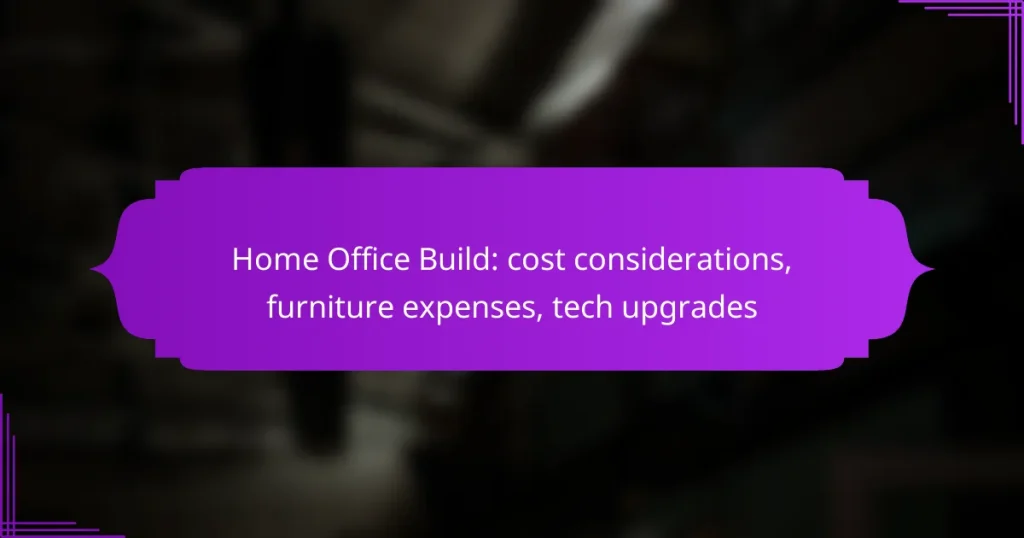Renovating your home can be a significant investment, with costs varying widely depending on the type of renovation and specific project details. In Canada, kitchen renovations can range from CAD 15,000 to CAD 50,000, while bathroom renovations typically fall between CAD 10,000 and CAD 30,000. Basement renovations generally start around CAD 20,000 and can go up to CAD 50,000, influenced by factors such as materials and labor rates.
Home Office Build: cost considerations, furniture expenses, tech upgrades
What are the costs of kitchen renovations in Canada?
The costs of kitchen renovations in Canada can vary significantly based on the scope of the project, materials used, and location. Homeowners typically spend anywhere from CAD 15,000 to CAD 50,000 or more, depending on their specific needs and preferences.
Average cost range for kitchen renovations
The average cost range for kitchen renovations in Canada generally falls between CAD 15,000 and CAD 50,000. Minor updates, such as new countertops and appliances, may cost around CAD 15,000 to CAD 25,000, while extensive remodels involving structural changes can exceed CAD 50,000. High-end finishes and custom cabinetry can push costs even higher.
For a mid-range kitchen renovation, homeowners can expect to spend approximately CAD 30,000 to CAD 40,000. This typically includes new cabinets, countertops, and flooring, along with updated lighting and plumbing fixtures.
Factors affecting kitchen renovation costs
Several factors can influence the overall costs of kitchen renovations. The size of the kitchen is a primary consideration; larger spaces require more materials and labor, increasing expenses. Additionally, the choice of materials plays a significant role, with high-quality or custom options costing substantially more than standard selections.
Labor costs can vary by region and the complexity of the project. Hiring specialized contractors for plumbing, electrical work, or custom cabinetry can add to the total. Other factors include the age of the home, which may necessitate updates to meet current building codes, and any unforeseen issues that arise during the renovation process.
What are the costs of bathroom renovations in Canada?
The costs of bathroom renovations in Canada typically range from CAD 10,000 to CAD 30,000, depending on the scope of work and materials used. Factors such as the size of the bathroom, quality of fixtures, and labor rates in your region will significantly influence the final price.
Typical expenses for bathroom renovations
Common expenses for bathroom renovations include labor, materials, and permits. Labor costs can account for about 20-35% of the total budget, while materials such as tiles, fixtures, and cabinetry can vary widely based on quality and style.
For example, basic fixtures may cost around CAD 100 to CAD 500, while high-end options can exceed CAD 1,500. Additionally, tile installation can range from CAD 5 to CAD 15 per square foot, depending on the type of tile chosen.
Key cost drivers for bathroom renovations
Several key factors drive the costs of bathroom renovations, including the size of the space, the complexity of the design, and the choice of materials. Larger bathrooms generally require more materials and labor, leading to higher expenses.
Moreover, if plumbing or electrical work is needed, costs can increase significantly. Upgrading to energy-efficient fixtures may have a higher upfront cost but can save money in the long run through reduced utility bills.
What are the costs of basement renovations in Canada?
The costs of basement renovations in Canada can vary significantly based on the scope of work and the materials used. On average, homeowners can expect to spend anywhere from CAD 20,000 to CAD 50,000 for a complete renovation, depending on the complexity and quality of finishes.
Average pricing for basement renovations
The average pricing for basement renovations typically falls between CAD 20,000 and CAD 50,000. Basic renovations, which may include drywall, flooring, and lighting, can start around CAD 20,000. More extensive projects that involve plumbing, electrical work, or custom finishes can push costs to CAD 50,000 or more.
For a mid-range renovation, homeowners might spend about CAD 30,000 to CAD 40,000, which often includes a bathroom addition and upgraded insulation. It’s advisable to obtain multiple quotes from contractors to get a clearer picture of potential costs.
Common factors influencing basement renovation costs
<pSeveral factors can influence the costs of basement renovations. The size of the basement is a primary consideration; larger spaces require more materials and labor. Additionally, the existing condition of the basement can affect costs; older basements may need structural repairs or waterproofing, which can add to the overall budget.
Another significant factor is the choice of materials. High-end finishes such as hardwood flooring or custom cabinetry will increase costs compared to standard options. Lastly, local labor rates and the complexity of the design can also impact the final price.
What are the costs of home additions in Canada?
The costs of home additions in Canada can vary significantly based on factors such as location, size, and complexity of the project. Generally, homeowners can expect to spend anywhere from CAD 100 to CAD 300 per square foot for a home addition, depending on these variables.
Estimated costs for home additions
The estimated costs for home additions in Canada typically range from CAD 20,000 to CAD 100,000 or more. A simple room extension may cost around CAD 20,000 to CAD 40,000, while more complex projects like adding a second story can exceed CAD 100,000. It’s essential to get multiple quotes from contractors to understand the market rates in your area.
Additional expenses may include permits, design fees, and potential landscaping or interior finishing costs. Always budget for unexpected expenses, which can add an extra 10-20% to your overall project cost.
Considerations impacting home addition expenses
Several factors can impact the expenses associated with home additions. Location plays a crucial role; urban areas often have higher labor and material costs compared to rural regions. The size and type of addition, whether it’s a simple bump-out or a full second floor, will also significantly affect the budget.
Permitting and zoning regulations can add to the costs as well. Homeowners should research local building codes and obtain necessary permits before starting the project to avoid fines or delays. Additionally, consider the potential need for architectural plans, which can add to upfront costs but may save money in the long run by preventing design errors.
How do renovation costs vary by region in Canada?
Renovation costs in Canada can differ significantly based on the region due to factors such as local demand, labor availability, and material costs. Understanding these variations is crucial for homeowners planning a renovation project.
Regional cost differences in major Canadian cities
Major cities like Toronto, Vancouver, and Montreal often experience higher renovation costs compared to smaller towns. For instance, average kitchen renovations in Toronto can range from CAD 25,000 to CAD 50,000, while similar projects in smaller cities might cost between CAD 15,000 and CAD 30,000.
In contrast, cities like Calgary and Ottawa may fall somewhere in the middle, with costs reflecting local market conditions. Homeowners should research specific neighborhoods, as even within a city, prices can vary widely.
Impact of local labor rates on renovation costs
Labor rates are a significant factor influencing renovation costs across Canada. Urban areas typically have higher labor costs due to increased demand for skilled tradespeople. For example, hourly rates for contractors in Toronto can exceed CAD 100, while rates in rural areas may be closer to CAD 70.
Homeowners should factor in these labor costs when budgeting for renovations. It’s advisable to obtain multiple quotes from local contractors to ensure competitive pricing and avoid overspending.
What financing options are available for renovations?
Homeowners have several financing options for renovations, including loans, grants, and incentives. Understanding these options can help you choose the best financial path for your project.
Types of renovation loans in Canada
In Canada, renovation loans typically include personal loans, home equity loans, and lines of credit. Personal loans are unsecured and can range from a few thousand to tens of thousands of dollars, while home equity loans leverage your property’s value, often offering lower interest rates.
Home equity lines of credit (HELOCs) allow you to borrow against your home’s equity as needed, providing flexibility for ongoing renovation costs. It’s crucial to compare interest rates and terms to find the best fit for your financial situation.
Government grants and incentives for renovations
The Canadian government offers various grants and incentives to encourage home renovations, particularly for energy efficiency upgrades. Programs like the Canada Greener Homes Grant provide financial assistance for improvements such as insulation and energy-efficient windows.
Additionally, some provinces offer their own incentives, which can include tax credits or rebates. Researching local programs can help maximize your funding options and reduce out-of-pocket expenses for your renovation project.
What are the hidden costs of renovations?
Hidden costs of renovations refer to unexpected expenses that can arise during a project, often leading to budget overruns. These costs can include everything from permits and inspections to unforeseen structural issues that may not be apparent until work begins.
Unexpected expenses during renovations
Unexpected expenses can significantly impact your renovation budget. Common examples include the need for additional materials, labor costs due to delays, and repairs for hidden damage like mold or electrical issues. It’s advisable to set aside an additional 10-20% of your total budget to cover these surprises.
Another potential hidden cost is the need for permits or inspections, which can vary by location. In some areas, failing to obtain the necessary permits can result in fines or the requirement to redo work, adding to your overall expenses.
Cost overruns and how to avoid them
Cost overruns occur when the final expenses exceed the initial budget, often due to poor planning or unexpected complications. To minimize the risk of overruns, create a detailed budget that includes all potential costs, and regularly review it throughout the renovation process.
Engaging a reliable contractor can also help manage costs effectively. Ensure they provide a clear estimate and communicate any changes promptly. Additionally, consider using a contingency fund for unforeseen expenses, which can help keep your project on track financially.
What are the trends in renovation costs for 2024?
In 2024, renovation costs are expected to continue rising due to inflation, supply chain issues, and increased demand for home improvements. Homeowners should anticipate a range of price increases across various renovation types, influenced by material costs and labor availability.
Emerging trends in renovation pricing
One notable trend is the growing popularity of sustainable materials, which can initially be more expensive but may lead to long-term savings. Homeowners are increasingly willing to invest in energy-efficient upgrades, such as solar panels or high-efficiency appliances, which can reduce utility bills over time.
Additionally, smart home technology is becoming a standard feature in renovations. Integrating smart systems can add to upfront costs but often enhances property value and appeal to tech-savvy buyers.
Predictions for renovation costs in the coming year
Experts predict that renovation costs may rise by around 5-10% in 2024, depending on the region and specific project. Factors such as labor shortages and fluctuating material prices will play a significant role in these increases.
Homeowners should budget for unexpected expenses, as renovations often uncover hidden issues that require additional funds. Setting aside a contingency of 10-20% of the total budget can help manage these surprises effectively.

